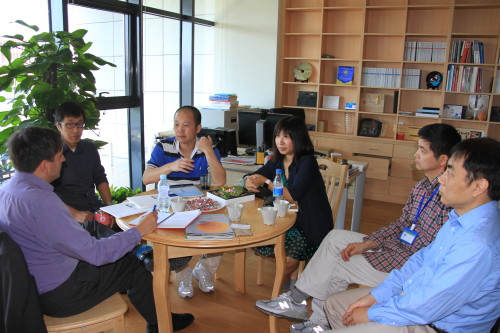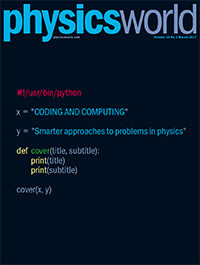Tag archives: computing
Coding and computing: the March 2017 issue of Physics World is out now
Physics these days wouldn’t succeed without software. Whether those lines of code are used to control new apparatus, make sense of fresh experimental data or simulate physical phenomena based on the latest theories, software is essential for understanding the world. The latest issue of Physics World, which is now live in the Physics World app for mobile and desktop, shines a light on how some physicists are exploiting software in new ways, while others are reinventing the hardware of a computer itself – binary isn’t the only way to go.
Sometimes there are so much data that software collaboration is the best way forward. In the issue, physicists Martin White and Pat Scott describe how the GAMBIT Collaboration is creating a new, open-source software tool that can test how theories of dark matter stack up against the wealth of data from various experiments such as direct searches for dark matter and the Large Hadron Collider. And with software development being so essential for physics research, data scientist Arfon Smith argues that we need to adopt better ways of recognizing those who contribute to this largely unrewarded activity. Columnist Robert Crease explores the other extreme: whether software can be patented.
Meanwhile, in an emerging field straddling both coding and computing, researcher Maria Schuld explains how quantum computers could enhance an already powerful software approach known as machine learning. (You can also read her article on physicsworld.com here.) Further into the realm of raw computing, physicist Jessamyn Fairfield describes the quest to develop a new kind of hardware that is physically, and functionally, similar to the computers inside our very own heads. As for how our brains process information, don’t miss a glimpse into the mind of physicist Jess Wade who has created a doodle based on the work Fairfield describes.
View all posts by this author | View this author's profile
Computing in a chilly Beijing
By James Dacey
Today is my first day in Beijing and boy am I glad I packed my winter coat. Despite the clear blue skies, it was just above freezing point as I arrived at the Beijing Computational Science Research Center (CSRC) this morning, with an icy wind bringing an added chill factor. I was with my IOP Publishing colleague Tom Miller as we were delivering a presentation about scientific publishing and journalism and our taxi driver decided that 2 km from the venue was as far as he fancied going. So a brisk walk later we arrived with chattering teeth in need of a thorough thaw.
Located a few kilometres north-west of Beijing’s centre, the CSRC is within the Zhongguancun hi-tech zone. The majority of buildings within the technology hub are occupied by commercial firms, and our icy walk took us past the impressive modern offices of Baidu and Lenovo among other companies. The CSRC, however, is focused primarily on the application of computational modelling to fundamental science research. Its seven divisions include physical systems, quantum physics & quantum information, and materials & energy.
View all posts by this author | View this author's profile
Highlights from Ada Lovelace Day 2016
By James Dacey
Today is Ada Lovelace Day (ALD), a day to celebrate the achievements of women in science, technology, engineering and maths (STEM). Named after the 19th-century polymath Ada Lovelace, the annual initiative also seeks to engage with the challenges of attracting more women into STEM careers and supporting career development. Now in its eighth year, the day includes a number of events and online activities.
The day will culminate in a few hours with Ada Lovelace Day Live!, a “science cabaret” event at the Institution of Engineering and Technology in London (18:30–21:30, tickets still available). In what promises to be “an entertaining evening of geekery, comedy and music”, the all-female line-up includes several scientists from the physical sciences. Among them is Sheila Kanani, a planetary physicist and science comedian who is the education, outreach and diversity officer for the Royal Astronomical Society in London.
View all posts by this author | View this author's profile
Chatting about Chinese computing

Calculated efforts: Matin Durrani (far left) in conversation with staff at the Beijing Computational Science Research Center, including Hai-Qing Lin (third left). (Courtesy: Mingfang Lu)
By Matin Durrani in Beijing, China
The last couple of days in the Chinese capital have been unusually damp and cool for the middle of June. Today, however, dawned sparklingly sunny as I headed off with my colleague Mingfang Lu from the Beijing office of the Institute of Physics, which publishes Physics World, to the Beijing Computational Science Research Center (CSRC) on the outskirts of the city.
Located on a shiny new software park, this sleek, five-storey building opened in March last year and looks just how you might expect the headquarters of IKEA to be – all minimalist corridors, big glass windows and the odd work of art dotted around. There’s even a fitness room in the basement. It’s currently got 43 full-time faculty, a third of whom are physicists, making this 45,000 m2 building – roughly the size of seven football pitches – seem remarkably sparse.
View all posts by this author | View this author's profile


